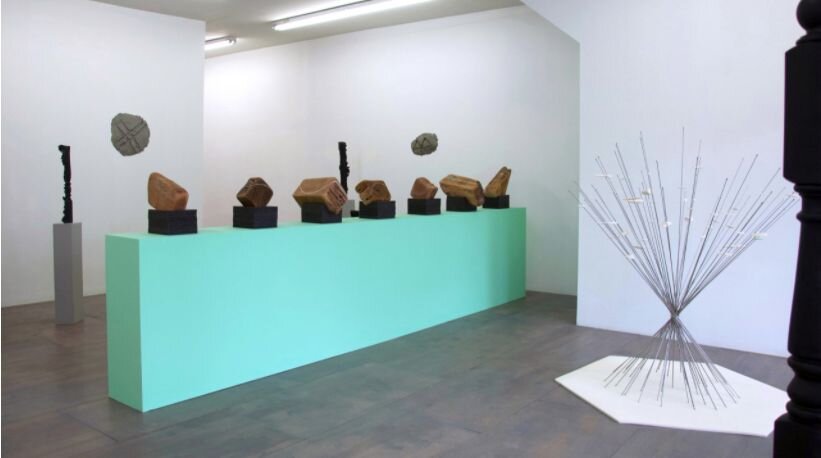COVID Reviews: Patrick O’Hare, Renegades, Kate Kretz, Anthony Sims, Claudia Wieser, Heather Mekkelson, Laura Berman
07/13/20
By Lori Waxman
This summer, art critic Lori Waxman writes reviews for artists whose work was affected by the COVID-19 pandemic. The first round of 60wrd/min COVID reviews came out two weeks ago; the second came out about a week ago.
Patrick O’Hare, “Greenpoint, New York, 2020,” photograph. (Also relevant: artist’s Instagram account , @patrickdohare).
Patrick O’Hare
Wandering in a city is not as unlike walking in nature as one might think. Walter Benjamin put it well when he wrote about going “botanizing on the asphalt.” It’s a seemingly paradoxical statement borne out by the photographs that Patrick O’Hare has made since the beginning ofNew York City’s lockdown order.Working first in Brooklyn and Queens, and later up in theHudson Valley, mostly in black and white but occasionally color, O’Hare has produced a series of pictures striking for their cohesion. Lines, shadows and stains command his attention regardless of whether he’s walking a forest trail or a sidewalk. The only real difference is whether these forms are created by utility lines and high rises or tree branches and ferns. The trick is to learn to perceive such things, and for that the lessons of the Situationist International are unparalleled. Their theory of the dérive, the drifting walk that has no purpose other than to be aware of one’s surroundings, to find the unexpected, to be influenced by what is already there but beneath most people’s notice, remains as pertinent now as it was in 1957 Paris. City or no city, wherever you are, open your eyes and pay attention. And then, if you happen to be a photographer like Patrick O’Hare, take a picture and share it onInstagram.
—Lori Waxman 2020-07-03 10:56 AM
Herb Greene’s “Prairie Chicken House,” 1961, in Norman, Oklahoma. Part of the exhibition “RENEGADES"."
RENEGADES: Bruce Goff and the American School of Architecture
In the United States, mid-century architecture isn’t just clean-lined Bauhaus and International Style boxes. It’s also those idiosyncratic forms that peak and swirl, bubble and facet, covered in wood shingles or limestone or corrugated metal. “RENEGADES” exhibits this alternative history, viewable through an interactive 3D tour of an installation in the galleries at the University ofOklahoma, whose school of design during the 1950s and 60s was where it all began, under the radical pedagogic leadership of Bruce Goff. The architects of what the curators have dubbed the“American School,”including Robert Faust and Donald MacDonald, created structures knowledgeable of global and indigenous forms but imitative of none; relentlessly experimental, they also paid great attention to context and materials. It’s inspiring to see photographs and models of these flights of fantasy built across Oklahoma and beyond—and all the more crushing to realize how many have been lost to arson, neglect, demolition and redevelopment.
—Lori Waxman 2020-07-04 3:32 PM
Kate Kretz, "One For The Team, part 6 of 7", pyrography (wood burning) on tree slices, dimensions variable (2" rounds to 12" rounds), 2016.
Kate Kretz
The greatness of America is a sham seemingly invulnerable to truth. But Kate Kretz is trying, and she will keep on trying, to expose it through#bullyculture, a monumental mixed media series she began thinking about in 2011that shows no signs of stopping. If only it could. The series currently includesKKK hoods and face masks made from deconstructed MAGA hats; a monumental painting of a half-naked oligarch gripping his penis amidst the splendor of tacky destruction; photorealistic images of sports fans, corporate raiders, and rape burned into tree slices; and a bullet hole through glass, embroidered on black cotton using gray hairs donated by people who have suffered profound loss. Kretz was scheduled to exhibit the series at Jen Tough Gallery in Santa Fe this month, but the gallery has lost its brick and mortar space in the coronavirus fallout. The irony is that, as the world continues to fall to pieces, Kretz’s unapologetically critical and direct art feels all the more necessary. Empty shop windows, anyone? This is what ought to be on display, to help ensure that what has long since passed for greatness will never be allowed to do so again.
—Lori Waxman 2020-07-05 1:16 PM
Anthony Sims, “I’m The Man That Did Not Get Ahead,” performance for video, 2020.
Anthony Sims
In “I’m The Man That Did Not Get Ahead,” meant to be a live performance but available instead through video, Anthony Sims combines three elements. The most literal are recorded gunshots. The most elegiac is a series of poems by Langston Hughes, played off a tape recorder and including “Let America Be America Again,” from which Sims takes his title and which repeats the crucial observation: America never was America to me. The “me” in Hughes’s case is all those historically oppressed by the American Dream, a dream made unavailable to them through the lash, the laws, the machine, poverty, bigotry, greed. Sims’s third element adds the visuals, as he traces his own body in chalk line after chalk line, an historical accumulation of bodies taken from their rightful owners by those who believe themselves to be the white inheritors of that Dream. Those are the elements Sims put in his performance, but as with all pertinent and powerful art, other elements cannot help but enter. Watching this video today, after weeks of demonstrations against the murder of Black people by the police, I hear an echo of protesters’ chants: Stop killing us.
—Lori Waxman 2020-07-06 9:21 AM
Claudia Wieser: Generations; Bemis Center for Contemporary Arts (installation view); 2020. Photo: Colin Conces.
Claudia Wieser
Among the exhibitions that closed before they ever opened is Claudia Wieser: Generations, at the Bemis Center in Omaha, Nebraska. That is a loss because Wieser’s particular brand of handmade geometric abstraction has a lot to offer our current moment. Not the crisis brought on by COVID-19 but the cultural reckoning with white supremacy that has been such a longtime coming. Wieser is by no means an overtly political artist, but in her many-faceted mirrors, her black and rainbow ceramic towers and plinths, and her wallpaper of fractured and solarized Greek statuary and urns, she also is. It takes all kinds—activist, conceptual, documentarian, satirical—and that includes the subtle variety of form and image making in which Wieser opens up modernist abstraction and classical idealism to include all colors, a range of shapes, a world of feelings, and the viewers themselves, whoever they are.
—Lori Waxman 2020-07-073:34 PM
Heather Mekkelson, Reverse Prophecies, installation view, 2020.
Heather Mekkelson
In Reverse Prophecies, her recently re-opened solo show at 65Grand in Chicago, Heather Mekkelson shows great tenderness toward material remains both human and arboreal. With meticulous and unusual use of epoxy clay, salvaged timber, foam-covered fabric, metal alloy, cement and more, she has created four distinct series, each of which looks from afar like a handsome piece of modernist abstract sculpture. Close inspection reveals individual meditations on what gets left behind: soap bar slivers, tree rings, genes, primitive mark-making. It’s also aesthetically exciting to examine Mekkelson’s sculptural experimentation, especially her delicate replacement of individual tree lines with a silvery substance that recalls kintsugi, the Japanese technique for fixing broken pottery with gold-dusted laminate. Ruination is thereby memorialized rather than being merely erased, as is the more typically American way.
—Lori Waxman 2020-07-08 3:49 PM
Laura Berman, “Earth and Sky 35,” acrylic and watercolor, 8 x 8in, 2017.
Laura Berman
Here is a list of associations drawn from tiny watercolor-gouache-acrylic studies, small collages, and large monoprints by Laura Berman: geologic strata, tulip petals, a hand curled inward, a body tucked inside itself, tree rings, succulents in a bowl, feline eyes, paw prints, butterfly wings, faceted gems, and bird eggs. Briefly shown as FUSE, a solo exhibition in the Drawing Room at Weinberger Fine Art in Kansas City, MO, which has since closed in the wake of the pandemic, the work is unabashedly full of awe for the things big and little of the natural world. It’s also all square, lending the regularity of scientific illustration to Berman’s project, a sense present in those pictures that seem to contain multiple views of an object under scrutiny: a sedimentary rock seen from above and the side, perhaps even sliced in half. Unscientifically, but definitely in keeping with the aesthetics of wonder, nearly everything is rainbow-hued. Taken all together, the three dozen gems of FUSE risk canceling one another out in a flood of gloriousness: even rainbows would become ordinary if seen every day.
—Lori Waxman2020-07-09 2:46 PM
The 60 wrd/min art critic is a project by Lori Waxman, the Chicago Tribune’s art critic and a professor of art history at the School of the Art Institute of Chicago. Her most recent book is Keep Walking Intently (Sternberg Press, 2017).







